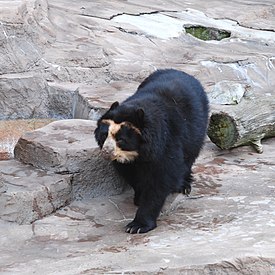Tremarctinae или короткомордые медведи[источник не указан 1952 дня] — это подсемейство медвежьих, которое включает одного живого представителя, очкового медведя (Tremarctos ornatus) из Южной Америки и несколько вымерших видов из четырёх родов: флоридский пещерный медведь (Tremarctos floridanus), короткомордые североамериканские медведи родов Plionarctos (P. edensis и P. harroldorum) и Arctodus (A. pristinus и A. simus), а также южноамериканские короткомордые медведи Arctotherium (включая A. angustidens, A. vetustum, A. bonariense, A. wingei и A. tarijense)[1].
Систематика
Традиционно Plionarctos и Tremarctos рассматривались как базальные группы по отношению к кладе, включающей роды Arctodus и Arctotherium[2][3]. Изучение сродства медведей, принадлежащих к Arctotherium, показывает, что они состоят в более близким родстве с очковым медведем, чем с Arctodus[4].
Таксономия
Следующая таксономия Tremarctinae представлена в работе Mitchell et al. (2016)[4]:
- Подсемейство Tremarctinae (Merriam & Stock, 1925)
- † Plionarctos (Frick, 1926)
- † Plionarctos harroldorum (Tedfored & Martin, 2001)
- † Plionarctos edensis (Frick, 1926)
- † Arctodus (Leidy, 1854) — короткомордые медведи
- † Arctodus simus (Cope, 1879)
- † Arctodus pristinus (Leidy, 1854)
- † Arctotherium (Burmeister, 1879) — арктотерии
- † Arctotherium angustidens (Gervais & Ameghino, 1880)
- † Arctotherium vetustum (Ameghino, 1885)
- † Arctotherium wingei (Ameghino, 1902)
- † Arctotherium bonariense (Gervais, 1852)
- † Arctotherium tarijense (Ameghino, 1902)
- Tremarctos (Gervais, 1855)
См. также
Примечания
- ↑ Krause J. Mitochondrial genomes reveal an explosive radiation of extinct and extant bears near the Miocene-Pliocene boundary (англ.) // BioMed Central[англ.] : journal. — 2008. — 28 July (vol. 8). — P. 220. — doi:10.1186/1471-2148-8-220. — PMID 18662376.
- ↑ Leopoldo H.; Soibelzon. The fossil record of the short-faced bears (Ursidae, Tremarctinae) from Venezuela. Systematic, biogeographic, and paleoecological implications (англ.) // Neues Jahrbuch für Geologie und Paläontologie, Abhandlungen[англ.] : journal. — 2007. — Vol. 244, no. 3. — P. 287—298. — doi:10.1127/0077-7749/2007/0244-0287.
- ↑ Leopoldo H.; Soibelzon. The largest known bear, Arctotherium angustidens, from the early Pleistocene pampean region of Argentina: with a discussion of size and diet trends in bears (англ.) // Journal of Paleontology[англ.] : journal. — Paleontological Society[англ.], 2011. — Vol. 85, no. 1. — P. 69—75. — doi:10.1666/10-037.1.
- ↑ 1 2 Kieren J. Mitchell, Sarah C. Bray, Pere Bover, Leopoldo Soibelzon, Blaine W. Schubert, Francisco Prevosti, Alfredo Prieto, Fabiana Martin, Jeremy J. Austin and Alan Cooper. Ancient mitochondrial DNA reveals convergent evolution of giant short-faced bears (Tremarctinae) in North and South America (англ.) // Biology Letters : journal. — Royal Society Publishing, 2016. — Vol. 12, no. 4. — P. 20160062. — doi:10.1098/rsbl.2016.0062. — PMID 27095265.
Ссылки
